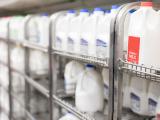Editor's note: This story deals with a commentary article written by CIDRAP scientists. CIDRAP News operates independently in relation to the center's research and policy programs.
May 10, 2013 (CIDRAP News) – If the H7N9 influenza virus now circulating in China evolves into a pandemic strain, the world is likely to have great difficulty providing adequate supplies of an effective vaccine in time to blunt its impact, according to a viewpoint article by three experts in the Journal of the American Medical Association (JAMA).
"Even with additional vaccine manufacturing capacity . . . the global public health community remains woefully underprepared for an effective vaccine response to a pandemic," says the commentary by Michael T. Osterholm, PhD, MPH, and colleagues with the University of Minnesota's Center for Infectious Disease Research and Policy, which publishes CIDRAP News.
The authors say an H7N9 vaccine may have limited effectiveness, given the performance of other H7 vaccines that have been tested. In addition, they say the vaccine might arrive too late to do very much good and that global vaccine production capacity may fall far short.
Two other experts who were not involved in writing the commentary agreed with it in some respects but were less pessimistic about the ultimate impact of an H7N9 vaccine, if one is needed.
The novel H7N9 virus was identified in China in late March and has sickened at least 131 people, killing 33 of them. The virus apparently is spreading to people from birds. It has shown some signs of adapting to humans, but no sustained human-to-human transmission has been seen so far. Most of the case-patients have been older, with a median age of 60, according to the JAMA authors.
The authors note that seasonal flu vaccine has moderate effectiveness—59% in working-age adults for the trivalent inactivated vaccine, or flu shot, according to a careful meta-analysis the same experts published as part of a report on flu vaccines last year. They found little evidence that existing flu vaccines provide good protection in elderly people. As for the 2009 pandemic vaccine, one study showed the effectiveness of the version used in the United States to be 56%.
"There is no reason to believe that a yet-to-be-developed pandemic A(H7N9) vaccine will perform any better than existing seasonal vaccines or the A(H1N1)pdm09 vaccines, particularly with regard to vaccine efficacy in persons older than 65 years," say Osterholm and colleagues.
They also observe that experimental vaccines for other H7 viruses, developed for pandemic preparedness, generated weak immune responses in early trials. In trials of two different inactivated vaccines that used larger-than-normal amounts of antigen, few or no volunteers had good antibody responses. A live attenuated vaccine for an H7N3 virus showed better results, however.
Another daunting problem is the timeline for producing a vaccine in quantity, the authors write. The Department of Health and Human Services (HHS) is developing H7N9 vaccine seed strains and planning to conduct phase 1 clinical trials, they explain, but large-scale production is unlikely to occur until a pandemic is considered imminent. They predict that once manufacturers receive vaccine orders, it will take them at least 4 months to produce vaccine lots for distribution.
Depending on when vaccines are ordered and other factors, including how fast the pandemic spreads, "it is possible that vaccines will arrive in limited quantities but after the critical point when they will significantly affect morbidity and mortality, as occurred in 1957, 1968, and 2009," the authors write.
The world's current production capacity for conventional flu vaccines (with the hemagglutinin [HA] head as the antigen) is about 4.54 billion 15-microgram (mcg) doses, they say. The amount of antigen needed for an H7N9 vaccine is unknown, but if it's 90 mcg, as was used in an H5N1 vaccine, global capacity would be only about 757 million doses of monovalent vaccine, or less than 15% of the global need, according to the analysis.
In an interview, Osterholm said he's worried about the public health community's credibility when it comes to flu vaccines.
"Public health has had a long history of overstating the effectiveness and our level of preparedness with influenza vaccine, and if we've learned no other lesson from the past, we need to be very careful how we state our level of preparedness," he said.
He added that the challenges in providing pandemic flu vaccines should cause the public health community to think much more seriously about non-vaccine-related interventions for fighting a pandemic.
Osterholm and colleagues have promoted the need for "game-changing" flu vaccines that would provide broader, more lasting protection than conventional vaccines using HA-head antigens.
"I'd give the US government a lot of credit for having tried to do what they can with existing technology to improve our response," he said. "But for preparedness, we have to have a game-changing improvement in vaccines."
John Treanor, MD, a veteran flu vaccine researcher at the University of Rochester, agreed about the difficulty of making a pandemic vaccine fast enough to have a great impact, but he was a little more optimistic on the question of vaccine effectiveness. He is a professor in the departments of medicine and of microbiology and immunology.
"I agree that the current technology for influenza vaccines inevitably means it would be very difficult to actually vaccinate the population ahead of a pandemic, because by the time a decision were made that a vaccine should be administered, it would already be too late," he said.
He said some advances over the past 20 years have sped the process somewhat, but "you're always left with the possibility that you won't be ready by the time the pandemic starts moving."
On the other hand, Treanor said, "I'm not as gloomy about the effectiveness of the vaccine as [Osterholm] is. Let's say it's 60% effective—it's not what we want, but that's not to say it doesn't work. It reduces the risk by more than half, so that's an effective intervention."
"I think the conclusion is that it'd be great if we had better vaccines," he added. "I don't think a single person would disagree with that."
Another flu expert, Arnold S. Monto, MD, an epidemiology professor at the University of Michigan, said he generally agrees with Osterholm and colleagues on a number of points, but he suggested that pandemic preparedness efforts in recent years have made a difference.
"Granted, this is going to be a difficult one," he said. "But we have to view it against the alternative of what else we have right now. Fortunately, the work on H5N1 has left us in a much better position to respond to this than if we had not done that work. It's pretty clear we're going to need an adjuvant, and there's been a lot of work on adjuvants." (Adjuvants are vaccine additives that boost the immune response, making it possible to vaccinate more people with a given amount of antigen.)
No adjuvanted flu vaccine has been licensed in the United States, but Monto said regulatory requirements should not be a big obstacle, because the Food and Drug Administration could issue an emergency use authorization.
Concerning flu vaccine effectiveness, he said, "We know it's lower than we'd like to see." But because no one has antibodies to H7 viruses, it will be important to provide a vaccine, even if its effectiveness is only modest, in his view.
If a vaccine could provide 70% effectiveness, which was the case with adjuvanted 2009 H1N1 vaccines in Europe, that would be "pretty great," Monto said. "And if as we believe—though we don't have as much evidence as we'd like—that [flu vaccines] do better against severe disease than against mild disease, we'd be preventing a lot of hospitalizations with this."
He also voiced confidence that recent advances in vaccine production technology, exemplified by Novartis's cell-culture vaccine facility in North Carolina, will make a difference in the ability to provide vaccine.
He declined to say whether he thinks it would now be possible to produce plenty of vaccine before the peak of a pandemic, but he said, "I don't think it's as gloomy with regard to the supply" as Osterholm and colleagues suggest.
See also:
May 9 JAMA article
Oct 15, 2012, CIDRAP News story "Complacency, misperception stymie quest for better flu vaccines"




















